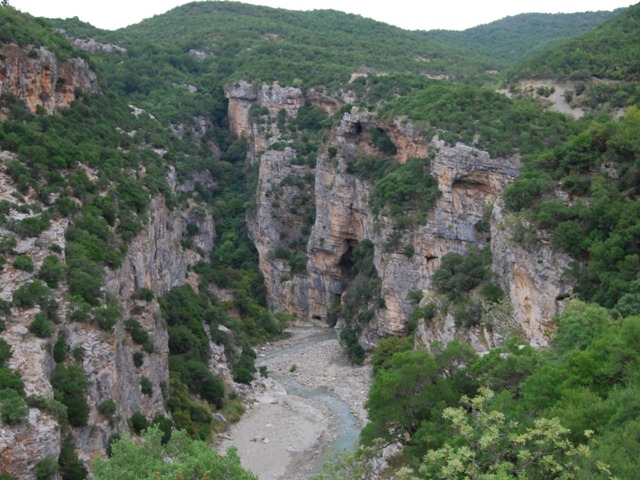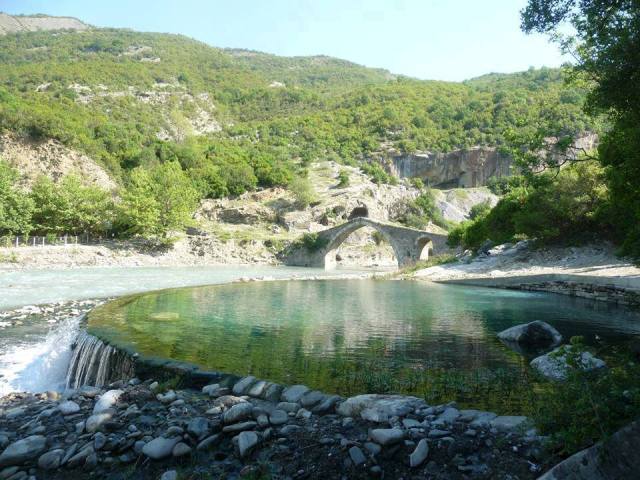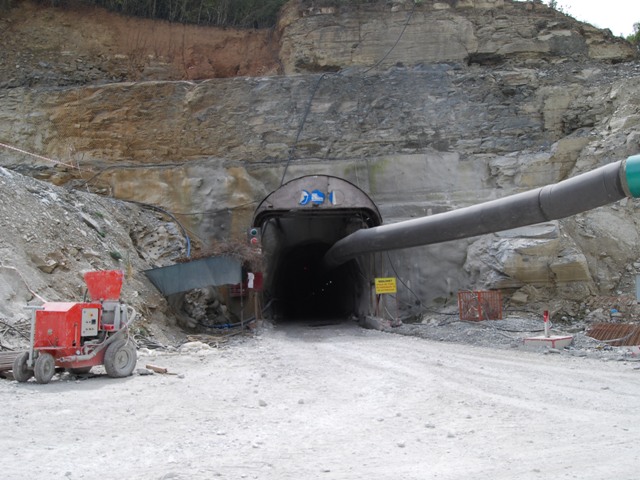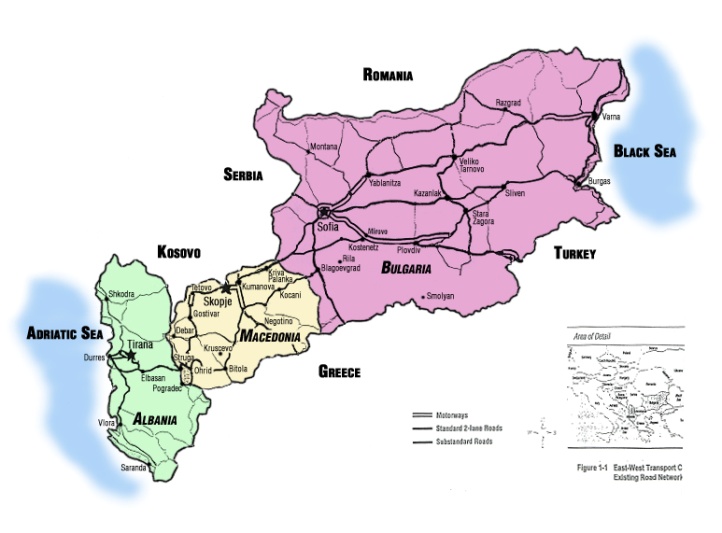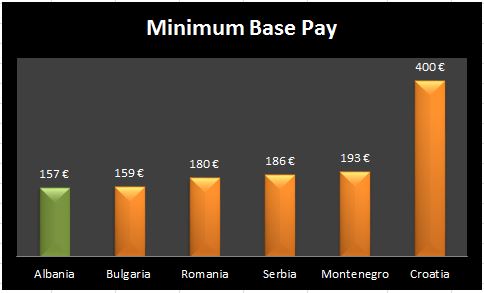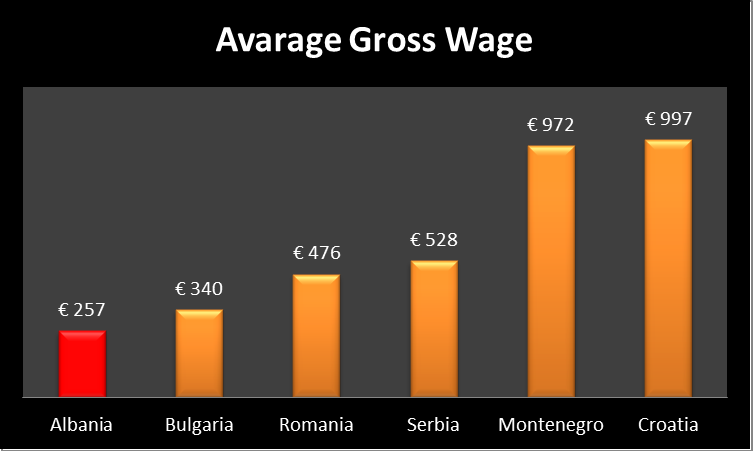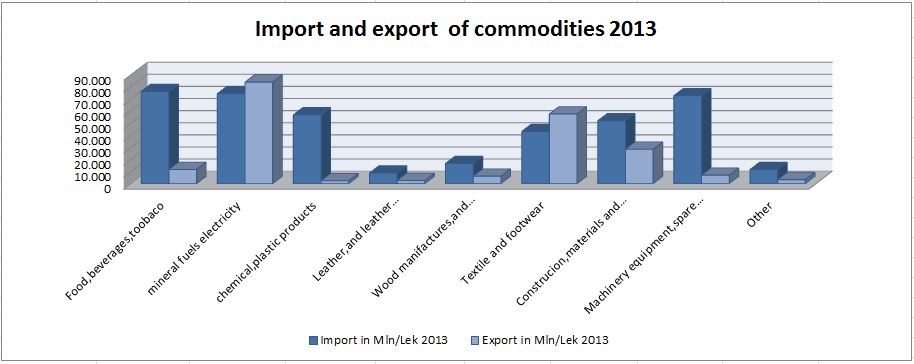World Bank Financed Power Plant Threatens Albanian Canyon
A hydropower plant, which the Austrian company ENSO is building in the Lengarica River in southern Albania with financing by the IFC, threatens to ruin a famous canyon, BIRN can reveal.
The heavy-duty trucks and earth-moving machinery working to construct a hydropower plant on the Lengarica River in southern Albania, close to the Greek border, look like alien imports in this pristine natural environment.
The river has cut a four-kilometre-long canyon through the limestone in the heart of the Hotova Pine national park, which is host to a series of thermal water springs, renowned for healing qualities, as well as a 17th-century bridge.
This ensemble of natural and cultural monuments enjoys the protection of the law. However, despite the law, and the area’s natural and cultural value, the government is allowing a hydropower plant to be built on the river, even though environmentalists fear it will severely damage the canyon.
The hydropower plant is being financed by the International Finance Corporation, IFC, the commercial arm of the World Bank, and is being constructed by an Austrian company, Enso Hydro, through a local subsidiary, Lengarica & Energy.
Documents obtained by BIRN and interviews with experts and government officials show that Lengarica & Energy’s initial application for a permit was rejected, owing to its negative impact on the Lengarica canyon and Hotova Pine national park.
However, an environmental permit for the project was ultimately approved, apparently following political pressure.
The river canyon is a natural monument enjoying Category 1 protection status under Albanian law, “which does not allow for any sort of construction,” Zamir Dedej, head of Albania’s Institute for Nature Protection, recalled.
Enso Hydro admits that the plant is being constructed in a “sensitive” natural environment, but insists that the project will have no impact on the canyon itself.
The company says that while it is using water that flows in the canyon, it is not actually building inside it, in the Category 1 area.
It also underlines that it has received all the construction permits it needs from the government – and says it is up to the authorities to monitor compliance with the permits.
“We were aware that it was a sensitive area,” Lengarica & Energy director Wolfgang Kropfl, said.
The World Bank, which controls 20 per cent of the project through its investment in Lengarica & Energy, underlines that it reviewed the project under IFC Environmental Performance Standards criteria before deciding to finance it.
Albania’s centre-left government took power in September 2013 after its predecessor had already given the project the final go-ahead. In the face of protests by environmental groups, it has set up a taskforce to review the potential environmental impact.
The Lengarica canyon is considered an exceptional natural monument owing to its geological form and the thick vegetation, which are home many species of birds.
Together with the Benja thermal springs and the 17th-century Kadiu Bridge, the canyon has drawn a growing number of tourists to the Hotova Pine national park. They have become an important source of revenue for local residents.
“People in Albania act like there is no tomorrow; they don’t think about the future,” Gorgio Ponti, coordinator of the tourists’ hospitality centre in the nearby town of Permet, complained.
“It’s paradoxical that the Albanian government wants to develop tourism in the area – and then opts to build a power plant,” he added.
The Lengarica project first took life in 2008, when the government awarded a concession to a little-known Albanian company, Hasi Energji, to build two small hydropower plants on the Lengarica.
Hasi Energji, which had little capital, then sold the concession in a series of transactions to Enso Hydro, which was scouting the possibilities of hydro power in Albania.
The Austrian company specializes in small hydropower plants, with plants in Austria, Norway and Turkey, as well as Albania.
To finance the project, Enso Hydro sought financing from the IFC and a German bank. Construction began in the summer of 2013, despite the objections of local environmental groups.
Documents secured by BIRN show that Hasi Energji originally planned to build a complex of villas near the Benja thermal spring and applied for a permit with this in mind in 2006.
However, the company then changed its mind and applied for a concession to build two small hydropower plants, Lengarica 1 and Lengarica 2, with an installed capacity of 3,700 and 2,500kW. It obtained a contract in 2008.
When Hasi Energji obtained the concession for the plants from the Ministry of Economy, it had capital assets of only 100,000 lek (€850), the minimum required by law to register as a company. Its only business experience was in the import and export of food materials.
Astrit Dhromaj,a former shareholder in the company, says the company never intended to develop the power plants itself. “We wanted to find a foreign company [to invest], which is what we did,” he told BIRN in a telephone interview.
In 2009, the Minister of Economy, Genc Ruli signed a contract with Hasi Energji, amending the concessionary agreement that the company had received earlier and reducing the number of power plants in the concession from two to one.
However, this single plant would have a much larger installed capacity than was originally planned, of 8,906 kW.
With the amended concession in its hands, Hasi Energji created a joint company with Enso Hydro in 2011, Lengarica & Energy, which first transferred 20 per cent of the shares to the Austrians and then sold them all the remaining shares for €800,000.
On August 3, 2011, Enso Hydro took control of all the shares of Lengarica & Energy.
Hasi Energji spent between 15,000 and 20,000 euro for the concession before selling it. “This was an important project and I think we made a good deal,” Dhromaj, the former shareholder in Hasi Energji, said.
After Enso Hydro took control of the company, the project to develop the larger single hydropower plant on the Lengarica moved forward.
The one problem was that since the time that Hasi Energji first obtained a concession and an environmental permit in December 2008, the government had declared the Hotova Pine area a national park.
This decision divided the park into four zones: a core area; an area of sustainable development; a recreational area; a traditional use area.
Following its acquisition of Lengarica & Energy, Enso Hydro developed a new project for the power plant.
Water would be taken in from the upper side of the canyon and deviated through a four-kilometre underground tunnel, which would then stretch another 3.75 kilometres above ground through tubes before reaching the power plant.
Of the total flow of the river at its peak, the power plant would use 8 metric cubes per second, leaving only 0.2 metric cubes per second to flow into the canyon, which the company says is enough to sustain its ecosystem.
When Lengarica & Energy bought the concession from Hasi Energji in 2011, it also had to reapply for a new environmental permit with the Ministry of Environment because the project now extended inside the boundaries of the Hotova Pine park.
Documents obtained by BIRN show that when Lengarica & Energy first applied for an environmental permit, the Ministry of Environment rejected it on October 4th, 2011.
The commission tasked with reviewing the project said building a power plant inside a national park protected by law was not feasible.
“Implementation of this project would cause considerable negative effects and damage the canyon in breach of the 2002 law on protected areas,” the ministry said.
“The deviation of the water flow will also damage the thermal springs near Benja at the end of the canyon,” it added.
The plant could “only be built if it used the water on the lower side of the canyon, after passing the Benja thermal water springs,” it continued.
However, after Lengarica & Energy reapplied for an environmental permit, only two months later, without changing the project, the same ministerial commission changed its mind. It approved the plant’s construction on January 21st, 2012.
A former ministry official, who spoke on condition of anonymity, told BIRN that the change of heart was the result of pressure applied by two MPs from the then ruling Democratic Party
“After I refused [to approve the project], I was fired directly on the order of the minister,” the official said.
The 2002 law on protected areas protects the Lengarica canyon from all development under Category I status. Article 5, section 2 of the law forbids all construction work in Category I areas.
However, Lengarica & Energy says this article of the law is not relevant to the project, which only involves diverting water away from the canyon, not construction work in the actual canyon.
“If it [the work] was not allowed, the government should have not given us the environmental permit,” company lawyer Vilma Gjyshi said. “As we were granted the permit, we have a right to develop the project,” she added.
Wolfgang Kropfl, director of Lengarica & Energy, says the power plant only stretches into so-called Category 2 protected areas – and work can take place in Category 2 areas with the necessary permits. “We are not working in the canyon,” Kropfl noted.
However, Sokol Abazaj, who worked as a consultant with Enso Hydro to develop the Lengarica project until 2012, told BIRN that Kropfl knew the project was controversial and had sought the area’s removal from the national park.
“Lengarica & Energy asked for the area to be removed from the national park,” Abazaj maintained.
“This request was never approved by Albanian institutions, although Kropfl, administrator of Lengarica & Energy… repeated it more than once,” he added.
Abazaj claims that conflicts over the environmental consequences of the project became a source of dispute between him and Kropfl.
“I told him that in Albania… there are laws and regulations that cannot be breached,” Abazaj said. “It will come out one day in the media that there is real catastrophe there,” he added, referring to the project.
Kropfl dismisses the allegations. The company had no reason to seek the removal of the planned area of work from the national park, he said. “As the company, we did nothing about this. Why should we do any removing, or lobby for this?” he asked.
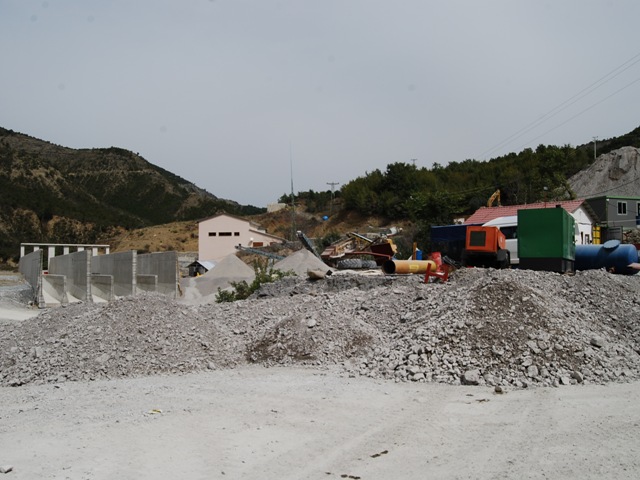 Kropfl also argues that – by deviating water away from the canyon – the project may prevent the lower part of the river from flooding during times of peak flow.
Kropfl also argues that – by deviating water away from the canyon – the project may prevent the lower part of the river from flooding during times of peak flow.
The IFC, meanwhile, told BIRN that the project had been evaluated “according to the IFC Sustainability Framework and the IFC Environmental and Social Performance Standards, which promote the protection of biodiversity and the sustainable management of natural resources.
“Based on information provided by the company, the Lengarica Project does not fall under protected area Category 1,” the IFC said. “The intake and tunnel fall under Category 2, and the… power house and part of substation fall under Category 3,” it added.
Referring to the 2002 law on protected areas, it continued: “Everything is designed in compliance with Article 6, point 3 a) of the law.”
Article 6, point 3 a) of the law does indeed permit activities that “change the natural state of water reservoirs, springs, lakes and water basins”. It says nothing about whether permission extends to such major projects as building hydropower plants, however.
While Lengarica & Energy insists that the plant is being built in the “sustainable development and traditional use” areas of the national park, the December 2008 government decision – which declared the Hotova Pine area a national park – underlined that only economic activity with a minimal impact on the environment should take place in the sustainable development area.
“In the sustainable development area, which serves as a buffer zone to the Category 1 core area, seasonal economic activities (grazing, collecting medicinal plants, secondary products from the forest), are allowed that do not have an impact on the ecological integrity of the ecosystem,” the decision read.
Contacted by BIRN, the ministries of Energy and Environment said they were awaiting the conclusions of a taskforce set up by both ministries, following the complaints by the local community and the environmental groups.
“We will analyze the conclusions of the joint taskforce in order to find out whether the concerns expressed by the community and civil society have any bases,” Energy Minister Damian Gjiknuri said.

